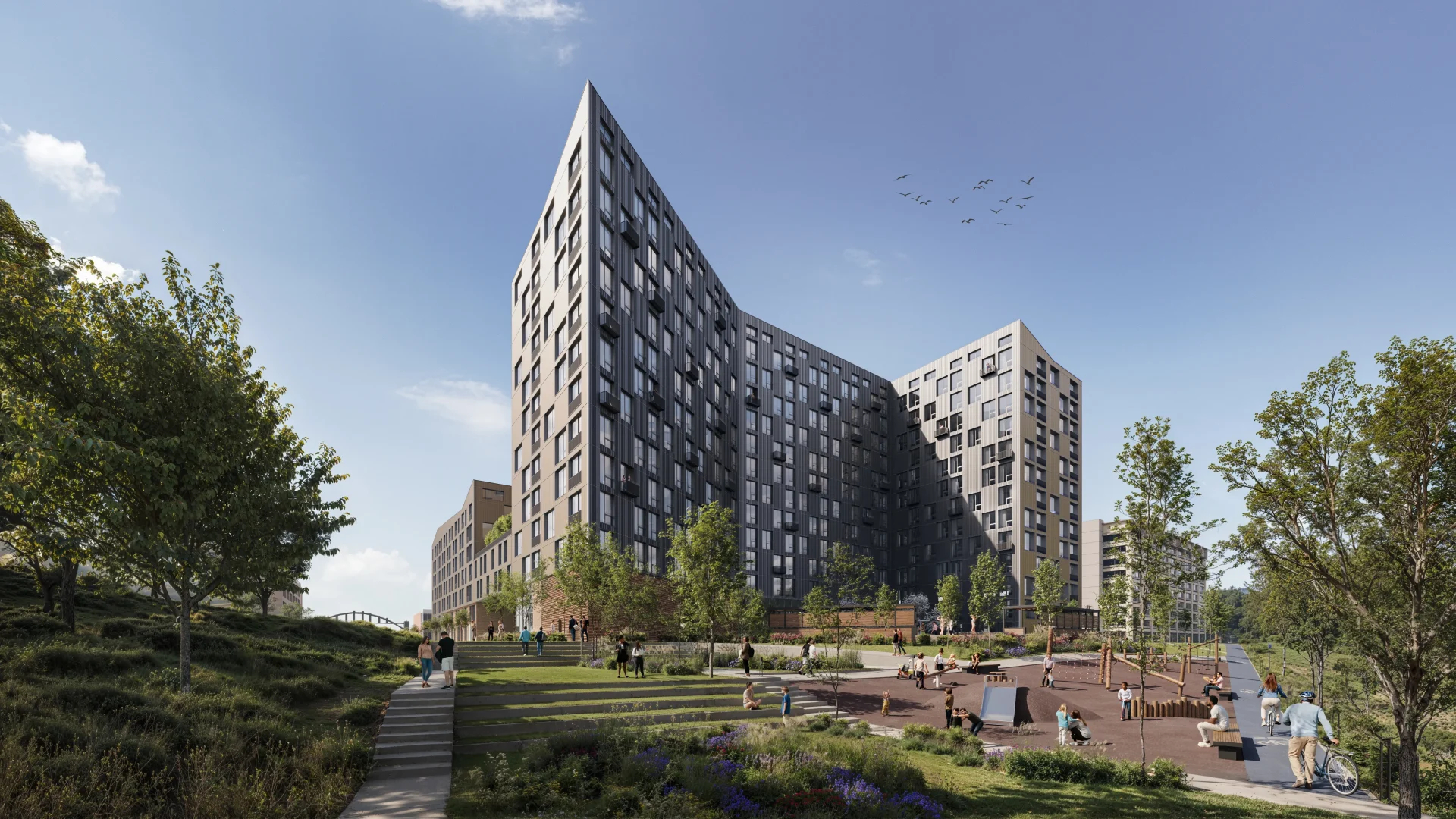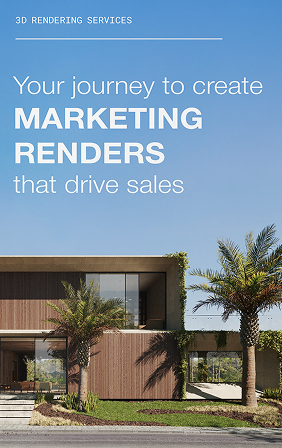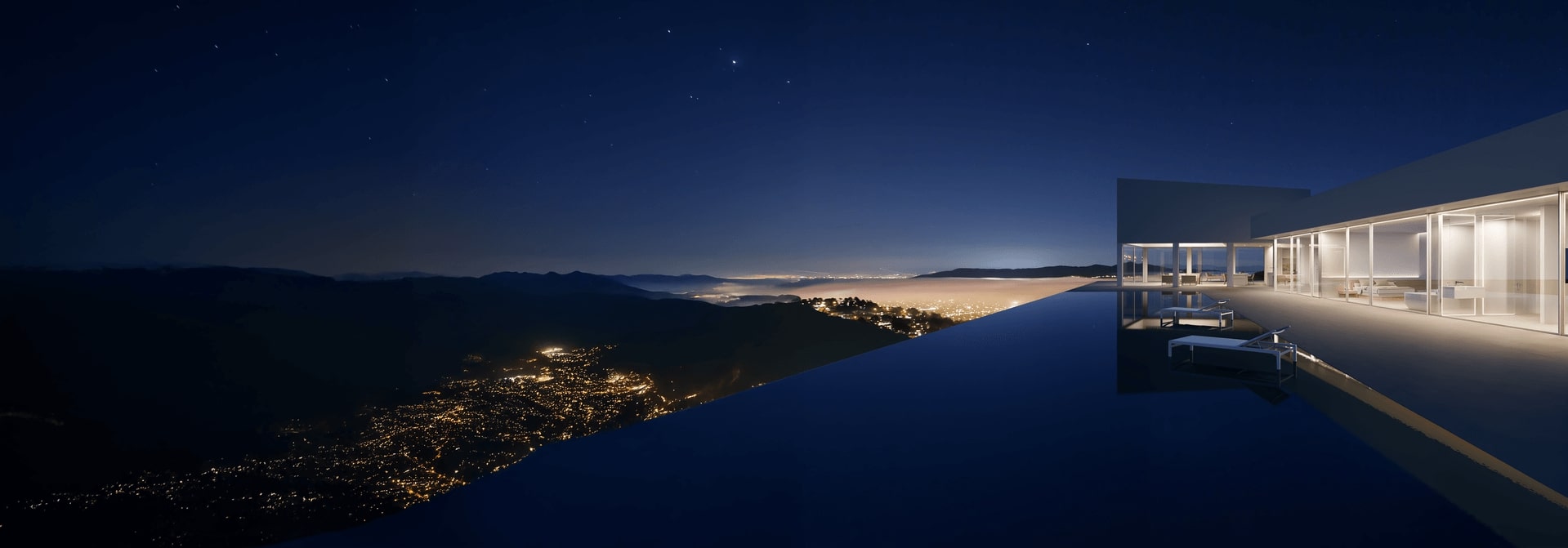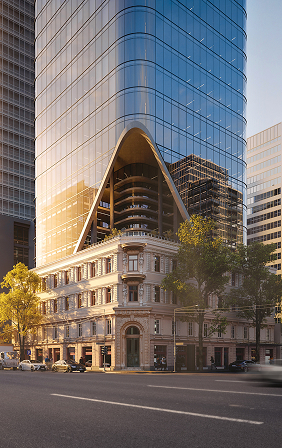3D exterior rendering provides architects, architectural visualizers, designers, and developers with the opportunity to visualize a project before its actual construction. Exterior rendering services offer many benefits. Today, we will analyze in detail what is included in such a multifaceted concept as 3D exterior rendering and explore who can use its capabilities to develop themselves and their business.
The famous architect Frank Gehry once said: ‘’Architecture should speak of its time and place, but yearn for timelessness.’’ It is for these reasons that we utilize exterior architectural visualization services. Our goal is not just to create a space, but to imbue it with meaning and make it memorable. While not all buildings can be world wonders, we strive to make every home a marvel for those who inhabit it.
What is a 3D exterior rendering?
Let’s start from the basics. Wikipedia defines 3D rendering as a process in computer graphics that transforms 3D wireframe models into 2D images, which may include photorealistic effects, on a computer. This might sound complex, but let’s simplify it. 3D rendering, especially of exteriors, involves creating photorealistic images of buildings or landscapes for portfolios. This includes everything from the building itself to the road beside it, birds in the sky, and the time of day to simulate sunlight. At Fortes Vision, we enhance the realism by adding people to the scene, creating a fully immersive experience for our architectural portfolio.
Now that we’ve clarified the term, let’s discuss the different types of exterior 3D rendering.
Types of 3D exterior rendering
There are several main approaches to 3D rendering, each with its own characteristics and purposes. Let’s analyze the main ones:
Photorealistic 3D rendering
This is the most common type of exterior visualization, focusing on creating highly detailed CG images that are as close to reality as possible. This includes accurate reproduction of textures, lighting, and atmospheric effects. This type of rendering is ideal for final architectural presentations, marketing materials, and regulatory approval processes where detail accuracy is important. Simply put, it’s the perfect service to showcase a project to stakeholders and ensure that the realization will closely match the visual representation.
Read also: WHAT MAKES PHOTOREALISTIC PEOPLE A MUST-HAVE IN ARCHITECTURAL VISUALIZATION?

Real-time rendering
This type provides dynamic interaction with a 3D model, allowing users to evaluate changes in lighting, textures, and other elements in real-time, including adjustments to render resolution. This method is widely used in virtual reality (VR) and interactive demonstrations, making it indispensable for architectural walkthroughs and interactive design sessions. Thanks to the full immersion in the project at any moment, complete with high-definition render resolution, the end user will be thoroughly impressed.
Non-photorealistic rendering (NPR)
Used to create images that resemble artwork more than exact copies of reality. These images can resemble drawings or sketches and are useful in the early stages of design when you need to convey a general concept without focusing on details.
Each of these rendering types serves a specific purpose and can be strategically used to enhance the presentation and understanding of architectural designs within the architectural visualization industry. By choosing the right type of rendering, architects and developers can more effectively communicate their visions and ensure that their projects are understood and appreciated by clients, investors, and the general public.
The role of exterior 3D rendering in building design and construction
The role of exterior 3D rendering in the realms of building design and construction has evolved significantly, becoming an indispensable part of the architectural process. As technology advances, the capabilities and impacts of 3D exterior visualization continue to expand, offering profound benefits across various stages of architectural development.
Exterior 3D visualization serves as a bridge between conceptual ideas and tangible structures. By creating detailed and accurate renderings, architects and designers are able to visualize the complete exterior design of a building before the commencement of physical construction. This capability is crucial not only for aesthetic evaluation but also for functional testing, allowing for adjustments to be made in the design phase, which can significantly reduce costs and resource wastage during construction. The selection of the appropriate camera angle is critical in these renderings, as it can greatly enhance the visibility of architectural features and the overall perception of the space.
Furthermore, 3D exterior rendering play a critical role in enhancing the communication between architects, developers, stakeholders, and clients. These visualizations provide a clear and compelling representation of a project, facilitating better understanding and engagement from non-technical stakeholders. This clarity helps in securing approvals and consents from planning authorities and investors, smoothing the path toward project realization.
In the competitive landscape of real estate development, the ability to present architectural projects in the most visually appealing manner can greatly influence decision-making. High-quality 3D exterior visualizations help real estate developers to market properties effectively. By showcasing realistic and attractive images of future buildings, potential buyers and tenants can make informed decisions, drawn by the visual allure of the renderings.
The integration of new technologies such as augmented reality (AR) and virtual reality (VR) with traditional 3D rendering processes is setting new standards in architectural visualization. These technologies provide immersive experiences, allowing clients and investors to take virtual tours of the exterior and interior of buildings before they are built. This immersive experience is invaluable for marketing high-end residential and commercial properties.
In summary, high-quality exterior rendering not only enhances the design and construction processes but also plays a vital role in marketing and client communications. As the technology progresses, its integration into the architectural and construction industries is expected to deepen, bringing more sophisticated tools that will further transform these fields.
Read also: GREEN BUILDING 3D RENDERING: A PRACTICAL GUIDE FROM OUR EXPERTS

Who needs 3D exterior visualization?
3D exterior visualization has become indispensable in many sectors, enhancing planning, development, marketing, and engagement in architectural projects. Here’s a detailed look at who benefits from this technology and how:
- Designers
Designers, particularly those in landscape and urban planning, significantly benefit from 3D exterior visualization to create and present their projects. This tool helps them to visualize outdoor spaces, including gardens, parks, and public spaces, in a realistic setting and understand how these designs integrate with architectural elements. Designers use 3D renderings to experiment with different layouts, materials, and plant arrangements, allowing for a comprehensive exploration of aesthetic and functional aspects of exterior design. For client presentations, these visualizations provide a tangible representation of the designer’s vision, greatly assisting in decision-making and approvals. Furthermore, it enhances communication, ensuring that all parties involved—be it clients, contractors, or regulatory bodies—have a clear understanding of the project in its context.
- Architects
Architects use 3D exterior visualization to bring their design concepts to life, offering a clear representation of their architectural style and intentions. This aids in refining design elements before construction and helps in convincing clients and stakeholders by presenting an immersive, photorealistic view of the proposed projects. Additionally, it allows architects to experiment with different design solutions and visualize the impact of their architectural projects within the existing environmental context.
- Real Estate Agents
Real estate agents utilize 3D visualizations to create compelling marketing materials that showcase properties in the most attractive way possible. By providing potential buyers and tenants with photorealistic images and virtual tours of properties, they can significantly boost interest and expedite sales or rentals. This tool is particularly valuable in pre-selling residential buildings or leasing commercial spaces before they are constructed.
- Big Companies
Big companies often engage in large-scale development projects that require detailed planning and visualization. Exterior rendering services enable these companies to visualize new facilities, expansions, or renovations and assess their impact on the corporate campus or infrastructure. This visualization helps align the project with strategic business objectives and facilitates communication across departments.
- Builders
Builders benefit from 3D exterior visualization by gaining a detailed understanding of the project before ground is broken. This technology helps prevent construction errors by providing a visual reference and assisting in troubleshooting potential issues in the construction process. It also helps in managing client expectations by showing what the finished structure will look like.
- Large Corporations
For large corporations, especially those with significant real estate holdings, 3D exterior visualizations are crucial for the detailed planning and execution of construction projects. They help in the decision-making process regarding property developments, facility upgrades, and the establishment of new branches or offices, ensuring that all developments align with the corporate image and operational needs.
- Homeowners
Individual homeowners planning to build custom homes use 3D visualizations to see their new homes before they are built. This helps them make informed decisions about exterior design elements, materials, and layouts. It also enables homeowners to communicate more effectively with architects and builders to ensure that the final product aligns with their expectations.
- Citizens
Citizens and community groups often require 3D visualizations to understand new developments within their communities. These visualizations are used in public consultations and presentations, providing a clear picture of proposed changes and their impacts on the neighborhood. This fosters transparency and allows for informed community feedback and engagement.
3D exterior visualization, including residential rendering, serves a broad spectrum of users by providing a powerful tool for visualization, planning, communication, and marketing. As this technology continues to evolve, its role in the architectural, construction, and real estate industries becomes increasingly vital, driving innovation and improving outcomes across all stages of property development, especially in residential rendering projects.
Impact of 3D exterior rendering on design and creativity
3D exterior rendering has significantly influenced architectural design and creativity, offering architects and designers an unprecedented ability to visualize, experiment, and refine their projects in real-time before any actual construction begins. This section explores how this technology has enhanced the design process and boosted creative potential.
Enhanced visualization. With 3D exterior visualization, designers can see their ideas come to life in a way that sketches and 2D drawings cannot match. This capability allows for a more nuanced understanding of how buildings and spaces will look and interact with their environments, encouraging more innovative architectural solutions.
Improved design accuracy. Exterior rendering services help in detecting design flaws that might not be evident in traditional blueprints or models. By identifying and addressing these issues early in the design process, architects can avoid costly modifications during construction, leading to more efficient project execution.
Facilitates client communication. Exterior rendering services provide a tool for architects to communicate their ideas to clients more effectively. Clients can visualize the final product more clearly, which helps in securing approvals faster. It also allows for easier adjustments based on client feedback, ensuring the final design aligns with their expectations.
Promotes experimentation. The flexibility of exterior rendering software enables designers to experiment with different materials, colors, and layouts quickly and easily. This flexibility encourages creativity and innovation, as designers can explore various aesthetic and functional options without the constraints of physical model building.
Integration with emerging technologies. The integration of 3D exterior renderings with technologies like virtual reality (VR) and augmented reality (AR) has created new opportunities for immersive design experiences. Architects can now walk through their rendered spaces, gaining a deeper understanding of spatial dynamics and aesthetic appeal, which can inspire further creativity.
Environmental and sustainable design. 3D exterior visualization also plays a critical role in environmental sustainability. It allows architects to simulate how environmental factors like sunlight, wind, and terrain affect a building. This enables the design of energy-efficient buildings that are not only cost-effective but also environmentally friendly.
Overall, exterior renderings have become a crucial tool in the architectural field, significantly impacting how buildings are designed, presented, and understood. As technology progresses, its influence on design creativity and architectural innovation continues to grow, pushing the boundaries of what is possible in architecture.
Read also: THE FUTURE OF ARCHITECTURE AND DESIGN: THE IMPACT OF ARTIFICIAL INTELLIGENCE (AI)
Conclusion
‘’Buildings are deeply emotive structures which form our psyche. People think they’re just things they maneuver through, but the makeup of a person is influenced by the nature of spaces’’ – David Adjaye. The nature of space profoundly influences us and our perception of the world, which is why we seek the highest photorealistic quality spaces around us. Exterior rendering services play a crucial role in achieving this. Choosing a 3D rendering company that employs experienced studios, professional visualizers, and skilled modelers can place you a step ahead in your projects, enabling the creation of stunning visuals. These experts leverage their deep understanding of 3D visualization to deliver significant benefits through their work. Being involved in the dynamic and fascinating world of 3D visualization, whether for business or personal purposes, proves to be both rewarding and impactful.
Your Journey | to Marketing Renders | That Bring Out | The Best in Your | Project
Read Our Whitepaper






